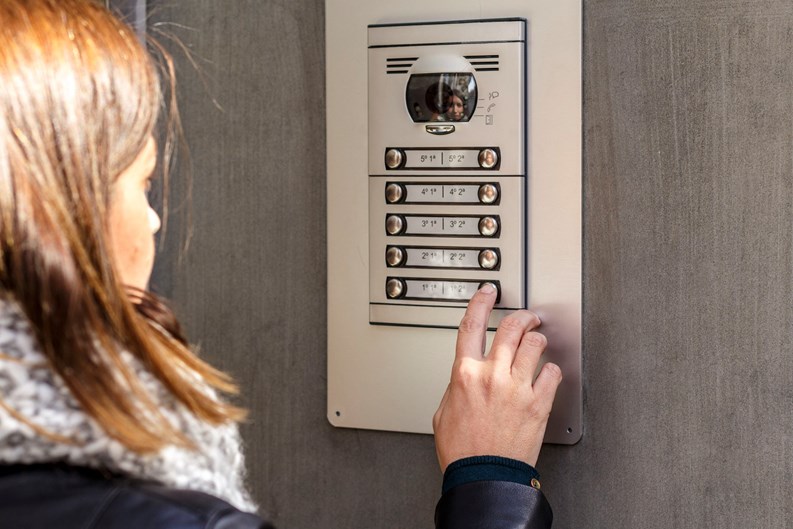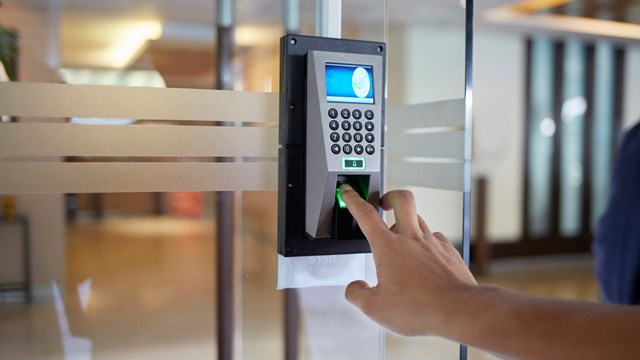Security is always a primary concern for homeowners. In a multifamily building without a doorman, the first line of defense is the front entrance – which more often than not features some sort of intercom system to enable visitors to announce themselves, and residents to let them into the building (or not).
Traditionally, intercom systems were audio-based. Over the past few decades, however, especially in new construction, video capabilities have been added to intercom systems. The limitation to both these audio-only and audio/video-systems is that they are tethered to the apartment; a resident had to physically be in the apartment in order to see or hear who was calling, and choose to grant them access. However, the recent advent and development of web- and phone-based video identification options are changing the picture entirely.
Making a Change
What’s involved with upgrading your intercom security system to something more in step with the times? That depends to a great extent on what you currently have, what you want, and whether you live in a full-service building. If there’s a live person at the front door, and maybe even one in the elevator as well, a simple audio-based system is usually sufficient. If your lobby is unattended – or if your building just has a vestibule, rather than a full lobby – you have options.
“When it comes time to replace an intercom,” explains Daniel Wollman, CEO of Gumley Haft Property Management in New York City, “it’s nearly impossible and not cost-effective to rewire a building, because the intercom wires are buried in the walls of each apartment. Repairing or replacing an intercom depends on the problem and where it originates. If the problems are apartment-related, you can’t rewire them. If the problem is system-related, you can probably change or replace the brains of the system. Intercoms are more efficiently replaced with a phone-based system, and that’s what we recommend and oversee in our buildings. In older, prewar buildings, we never replace the intercom – we go straight to a phone-based system.”
“The market for tech has gotten better and better,” says Barak Ron, the CEO of Vertex Security, also located in New York. “There are two main paths to upgrading: using existing wiring, or running new wiring. Most new technology is IP based – it’s the same signal that goes to the router for your computer. The systems combine intercom and cameras, have the ability to provide more features, and are easy to control from your cell phone.
“The video data,” Ron continues, “is hardwired to the front panel of the unit. The new IP system provides digital data to an app on your phone, and you can answer not only in your apartment, but anywhere you might be. You could be in Europe and still not miss your UPS delivery. These apps are most popular with today’s users. They may have need for door access for multiple reasons, in addition to deliveries: dog walkers, nannies, cleaning people. Now they can identify them and open the door themselves.”
Drawbacks, Cost and Convenience
While remote access via smartphone may offer convenience, Bob Maunsell, president of Electronic Security Group, located in West Boylston, Massachusetts, does acknowledge a benefit of traditional hardwired systems. “They’re very secure,” he says. “You have to be in the apartment to let someone in. Someone has to be at the front door. We can add video to these older systems. We can also sync them with the local cable provider to create a ‘channel’ on the resident’s television from which to view the front door. On a phone-based system, you can identify someone at your door from anywhere on earth. Is that good or bad?”
In terms of security, tech can have some drawbacks – but clearly, one of the benefits of upgrading your existing audio-based system to a phone-based app for video is cost. Adding an LED video screen to each unit is possible, but expensive. “Running new wiring is expensive, labor intensive, time consuming, and intrusive,” says Ron. “It takes a lot of time. The wiring has to be run to each floor, and then to each apartment. Residents have to be present to provide access, and that’s inconvenient. Using existing wiring is simple. And as wires are buried within walls, there’s no need to break down and replace plaster. It’s simple; we just set up a new front panel and whatever other components are necessary in the basement. We may need 10 minutes per apartment for testing.”
Ron estimates that labor costs for new wiring are more than double what’s required for an upgrade using existing systems. Typically for, say, a six-story, 50-unit elevator building, full replacement with rewiring can run about $50,000-$60,000, or about $1,000+ per unit. Maunsell puts that estimate in Massachusetts at around $700-$800 per unit.
There are costs involved with phone-based systems as well. There are annual fees that must be paid for the app, though they don’t approach the cost per unit of physical replacement. “The most current technology,” says Ron, “has appeared in the past six months or so. It connects the existing wiring to the wifi system in an individual apartment.” Everything is integrated.
That integration is a huge draw – perhaps even a requirement – for millennials, the largest and fastest-growing segment of the market for these products. As they continue to enter both the workforce and the housing market, younger individuals and families are seeking the highest level of technology in everything. And for them, that technology is phone-based. “To a great extent,” says Ron, “the type of upgrade will depend on who lives there. Millennials require all the technology bells and whistles. They often choose residences based on the tech available. The high-tech nature of these systems is also good for landlords, as they can pass the cost along to tenants.” In co-op and condo situations, the more current the technology, the higher the price a shareholder or owner can ask, should they need to sublet or lease out their units, or when they sell.
Maunsell confirms this trend. In downtown Boston, where the residential demographic tends to trend younger, the demand for the highest tech amenities, including intercom and other building entrance options, is very high. “When you have ‘cruise-ship’ living,” he says, “it’s all about amenities. Millennials with money to burn want the best. They prefer mobile phone-based apps.”
A Case in Point
When preparing to take on a new client building, Ron asks a good number of questions before his crew sets foot on the property. He wants to know who lives in the building; he asks the board what it is seeking and why, and makes an inspection before making recommendations, which can run from installing all-new wiring to a phone-base app, to leaving the current system in place as-is.
In one recent instance, he was contacted by a cond-op building in New York City. The 32-story, 586-unit property was built in the 1960s and was in excellent condition. The property had doorman service, but the board was seeking to rewire and install an LED video intercom system to all the apartments in the building – a job that could cost upwards of $500,000. “They didn’t need it,” says Ron. “I convinced them not to re-wire because it wasn’t necessary. They have doorman security. There was no point to putting in cameras with screens in all the units. What would they see – the doorman letting the delivery through? There was no need for an upgrade.”
Suburban Options
Security issues are not limited to urban environments such as New York or Boston, of course. They are found in suburban condo and HOA developments as well. Often, the needs of those communities are driven by the age of the property. Like any system in a housing community, intercom communication systems can become obsolete, or may suffer from simple deterioration and require replacement. In these situations, explains Maunsell, the owners often want only telephone entry, and adding that to their phones is a big upgrade.
In our world of ever-increasing technology, intercoms entry systems can be just one more problem solved through our cell phones. Today, it’s all in the palm of our hands.
A J Sidransky is a staff writer/reporter for New England Condominium, and a published novelist.







Leave a Comment